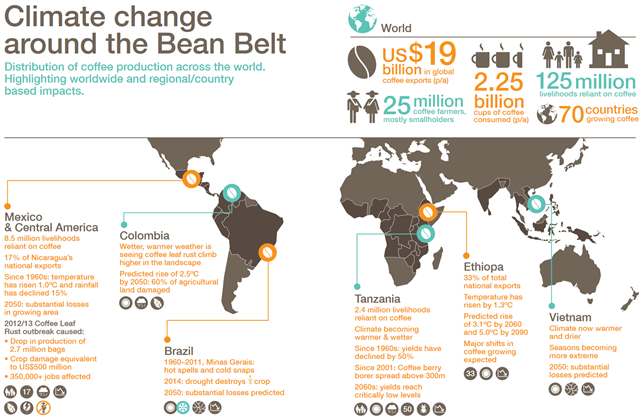Global warming threatens world’s coffee supply
By Jonah Engel Bromwich
22 September 2016 (The New York Times) – A report examining the many ways climate change threatens coffee and coffee farmers has alarmed people who are now imagining what it would be like getting through the day without their caffeine fix. The report, released this month by the Climate Institute, a nonprofit organization in Australia, was commissioned by Fairtrade Australia and New Zealand, the regional hub of the global Fairtrade system. Though it contains little new research, it has made waves by collating an array of available literature indicating that climate change will have a stark effect on the world’s coffee supply. The report emphasizes the threat warming temperatures pose to farmland, citing a study from the March 2015 issue of the journal Climatic Change that found climate change “will reduce the global area suitable for coffee by about 50 percent across emission scenarios.” In addition to the disappearing land on which to grow coffee, the report highlights the way warmer weather is exacerbating the threat of diseases like coffee rust and pests like the coffee berry borer, a type of beetle that a 2011 report said caused annual losses of hundreds of millions of dollars in coffee beans. [more]
Climate Change Threatens World’s Coffee Supply, Report Says 
Coffee is a key global crop and the second most valuable commodity exported by developing countries, worth around US$19 billion in 2015. Worldwide, around 2.25 billion cups of coffee are consumed each day. Nearly half of all Australians drink coffee regularly. The coffee market is growing, but faces big challenges coming up fast:
- There is strong evidence that rising temperatures and altered rainfall patterns are already affecting coffee yields, quality, pests, and diseases—badly affecting economic security in some coffee regions.
- Without strong action to reduce emissions, climate change is projected to cut the global area suitable for coffee production by as much as 50 per cent by 2050. By 2080, wild coffee, an important genetic resource for farmers, could become extinct.
- Leading global coffee companies, such as Starbucks and Lavazza, publicly acknowledge the severe risks posed by climate change to the world’s coffee supply. Consumers are likely to face supply shortages, impacts on flavour and aroma, and rising prices.
- In the next few decades, coffee production will undergo dramatic shifts—broadly, away from the equator and further up mountains. Production will probably come into conflict with other land uses, including forests.
- Rising CO2 levels may boost the growth and vigour of the coffee plant, but there is no guarantee this ‘fertilisation effect’ will offset the risks imposed by a more hostile climate.
A Brewing Storm: The climate change risks to coffee
ABSTRACT: Coffee has proven to be highly sensitive to climate change. Because coffee plantations have a lifespan of about thirty years, the likely effects of future climates are already a concern. Forward-looking research on adaptation is therefore in high demand across the entire supply chain. In this paper we seek to project current and future climate suitability for coffee production (Coffea arabica and Coffea canephora) on a global scale. We used machine learning algorithms to derive functions of climatic suitability from a database of geo-referenced production locations. Use of several parameter combinations enhances the robustness of our analysis. The resulting multi-model ensemble suggests that higher temperatures may reduce yields of C. arabica, while C. canephora could suffer from increasing variability of intra-seasonal temperatures. Climate change will reduce the global area suitable for coffee by about 50 % across emission scenarios. Impacts are highest at low latitudes and low altitudes. Impacts at higher altitudes and higher latitudes are still negative but less pronounced. The world’s dominant production regions in Brazil and Vietnam may experience substantial reductions in area available for coffee. Some regions in East Africa and Asia may become more suitable, but these are partially in forested areas, which could pose a challenge to mitigation efforts.
A bitter cup: climate change profile of global production of Arabica and Robusta coffee
